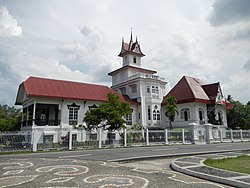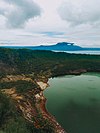
Emilio Aguinaldo y Famy was a Filipino revolutionary, statesman, and military leader who is the youngest president of the Philippines (1899–1901) and became the first president of the Philippines and of an Asian constitutional republic. He led the Philippine forces first against Spain in the Philippine Revolution (1896–1898), then in the Spanish–American War (1898), and finally against the United States during the Philippine–American War (1899–1901).
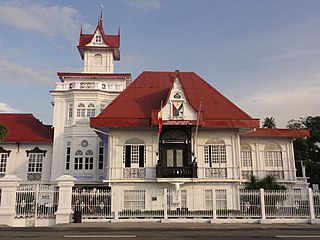
Cavite, officially the Province of Cavite, is a province in the Philippines located in the Calabarzon region in Luzon. Located on the southern shores of Manila Bay and southwest of Manila, it is one of the most industrialized and fastest-growing provinces in the Philippines. As of 2020, it has a population of 4,344,829, making it the most populated province in the country if the independent cities of Cebu are excluded from Cebu's population figure.

The national flag of the Philippines is a horizontal bicolor flag with equal bands of royal blue and crimson red, with a white, equilateral triangle at the hoist. In the center of the triangle is a golden-yellow sun with eight primary rays, each representing a province. At each vertex of the triangle is a five-pointed, golden-yellow star, each of which representing one of the country's three main island groups—Luzon, Visayas, and Mindanao. The white triangle at the hoist represents liberty, equality, and fraternity. A unique feature of this flag is its usage to indicate a state of war if it is displayed with the red side on top, which is effectively achieved by flipping the flag upside-down.

Malacañang Palace, officially known as Malacañan Palace, is the official residence and principal workplace of the President of the Republic of the Philippines. It is located in the Manila district of San Miguel, along Jose P. Laurel Street though it is commonly associated with Mendiola Street nearby. The term Malacañang is often used as a metonym for the president, their advisers, and the Office of the President of the Philippines. The sprawling Malacañang Palace complex includes numerous mansions and office buildings designed and built largely in the bahay na bato and neoclassical styles. Among the presidents of the present Fifth Republic, only Gloria Macapagal Arroyo actually lived in the main palace as both her office and her residence, with all others residing in nearby properties that form part of the larger palace complex. The palace has been seized several times as a result of protests starting with the People Power Revolution of 1986, the 1989 coup attempt, the 2001 Manila riots, and the EDSA III riots.

The Philippine Revolution was a war of independence waged by the revolutionary organization Katipunan against Spain from 1896 to 1898. It was the culmination of the 333-year colonial rule of Spain to the archipelago. The Philippines were among the last colonies of the Spanish Empire, which saw a massive decline particularly in the 1890s. Cuba rebelled in 1895, and the empire soon fought against the United States in a war that they lost. In June 1898, Philippine revolutionaries declared independence. However, this was not recognized by Spain, which sold the islands to the United States in the Treaty of Paris.

Imus, officially the City of Imus, is a 3rd class component city and de jure capital of the province of Cavite, Philippines. According to the 2020 census, it has a population of 496,794 people.

Kawit, officially the Municipality of Kawit, is a 1st class municipality in the province of Cavite, Philippines. According to the 2020 census, it has a population of 107,535. It is one of the notable places that had a major role in the country's history during the 1800s and 1900s.

Baldomero Aguinaldo y Baloy was a leader of the Philippine Revolution. He was the first cousin of Emilio Aguinaldo, the first president of the Philippines, as well as the grandfather of Cesar Virata, a former prime minister in the 1980s.

Miguel Malvar y Carpio was a Filipino general who served during the Philippine Revolution and, subsequently, during the Philippine–American War. He assumed command of the Philippine revolutionary forces during the latter, following the capture of resistance leader Emilio Aguinaldo by the Americans in 1901. According to some, he could have been listed as one of the presidents of the Philippines. However, is not recognized as such by the Philippine government.
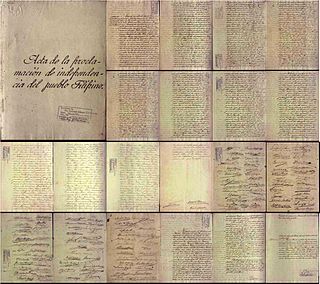
The Philippine Declaration of Independence was proclaimed by Filipino revolutionary forces general Emilio Aguinaldo on June 12, 1898, in Cavite el Viejo, Philippines. It asserted the sovereignty and independence of the Philippine islands from the 300 years of colonial rule from Spain.

Independence Day is a national holiday in the Philippines observed annually on June 12, commemorating the declaration of Philippine independence from Spain in 1898. Since 1978, it has been the country's National Day.

The Philippine Republic, now officially remembered as the First Philippine Republic and also referred to by historians as the Malolos Republic, was established in Malolos, Bulacan during the Philippine Revolution against the Spanish Empire (1896–1898) and the Spanish–American War between Spain and the United States (1898) through the promulgation of the Malolos Constitution on January 22, 1899, succeeding the Revolutionary Government of the Philippines. It was formally established with Emilio Aguinaldo as president. It maintained governance until April 1, 1901.
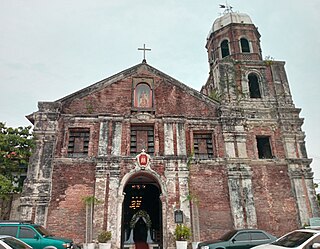
The Diocesan Shrine and Parish of Saint Mary Magdalene, also known as Kawit Church, is the parish church of the municipality of Kawit, Cavite in the Philippines. The Roman Catholic church is one of the oldest churches in the Philippines, construction of the present church was started in 1737. The church, named after Jesus' disciple Mary Magdalene, was last restored in 1990 by the citizens of Kawit.
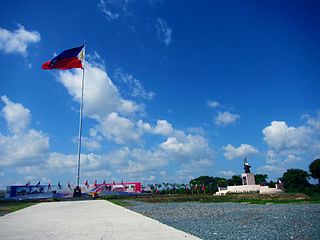
The Battle of Alapan was fought on May 28, 1898, and was the first military victory of the Filipino Revolutionaries led by Emilio Aguinaldo after his return to the Philippines from Hong Kong. After the American naval victory in the Battle of Manila Bay, Aguinaldo returned from exile in Hong Kong, reconstituted the Philippine Revolutionary Army, and fought against the Spanish troops in a garrison in Alapan, Imus, Cavite. The battle lasted for five hours, from 10:00 A.M. to 3:00 P.M.

The Baldomero Aguinaldo Shrine is a single-detached house built by Baldomero Aguinaldo, cousin of Emilio Aguinaldo during the American colonial period in 1906 at Binakayan, Kawit, Cavite. Baldomero held several positions at the revolutionary government during the early 1900s. He became the head of the Kawit Chapter of the Katipunan, President of the KKK Magdalo Council, and Secretary of the Treasury in the 1897 Biak-na-Bato Republic. Also, he became the Secretary of War and Public Works after the establishment of the First Philippine Republic by Emilio Aguinaldo.
The Gen. Emilio Aguinaldo Museum or simply known as the Aguinaldo Museum is a history museum in Baguio, Philippines.
National Route 62 (N62) forms part of the Philippine highway network. It runs south from Metro Manila to northeastern Cavite.

The Tirona Highway is a two-to-four lane, primary highway in Cavite, Philippines. It connects the city of Bacoor and the municipality of Kawit. It was named for Filipino revolutionary leader Daniel Tirona. The Aguinaldo Shrine, the site of the Philippine Declaration of Independence and residence of Emilio Aguinaldo, is located along the road.

The Pamintuan Mansion is a historic building in Angeles City, Philippines built by the Pamintuan family in the 1880s. It was briefly used by the Katipunan during the Philippine-American War. It currently hosts a social science museum.
